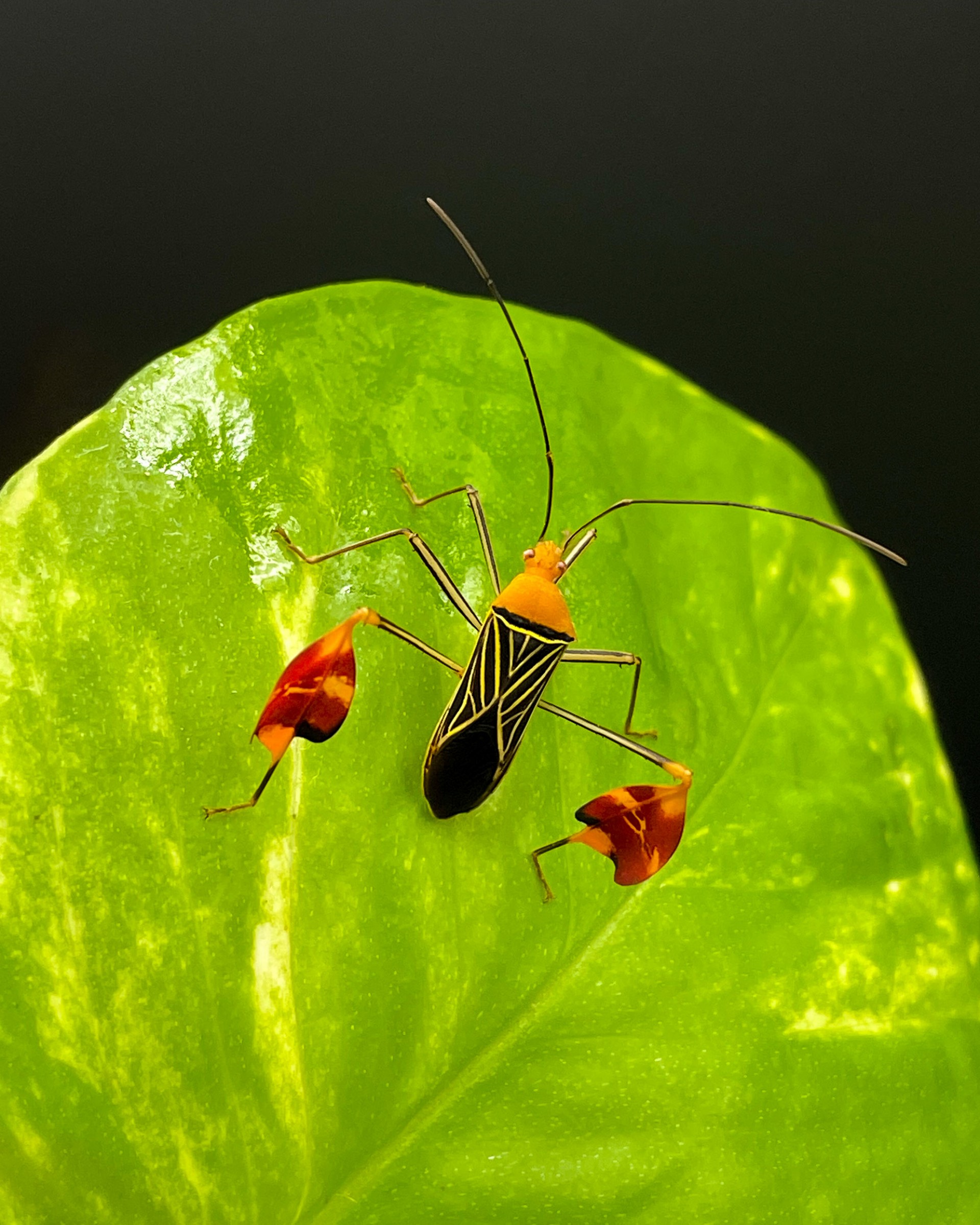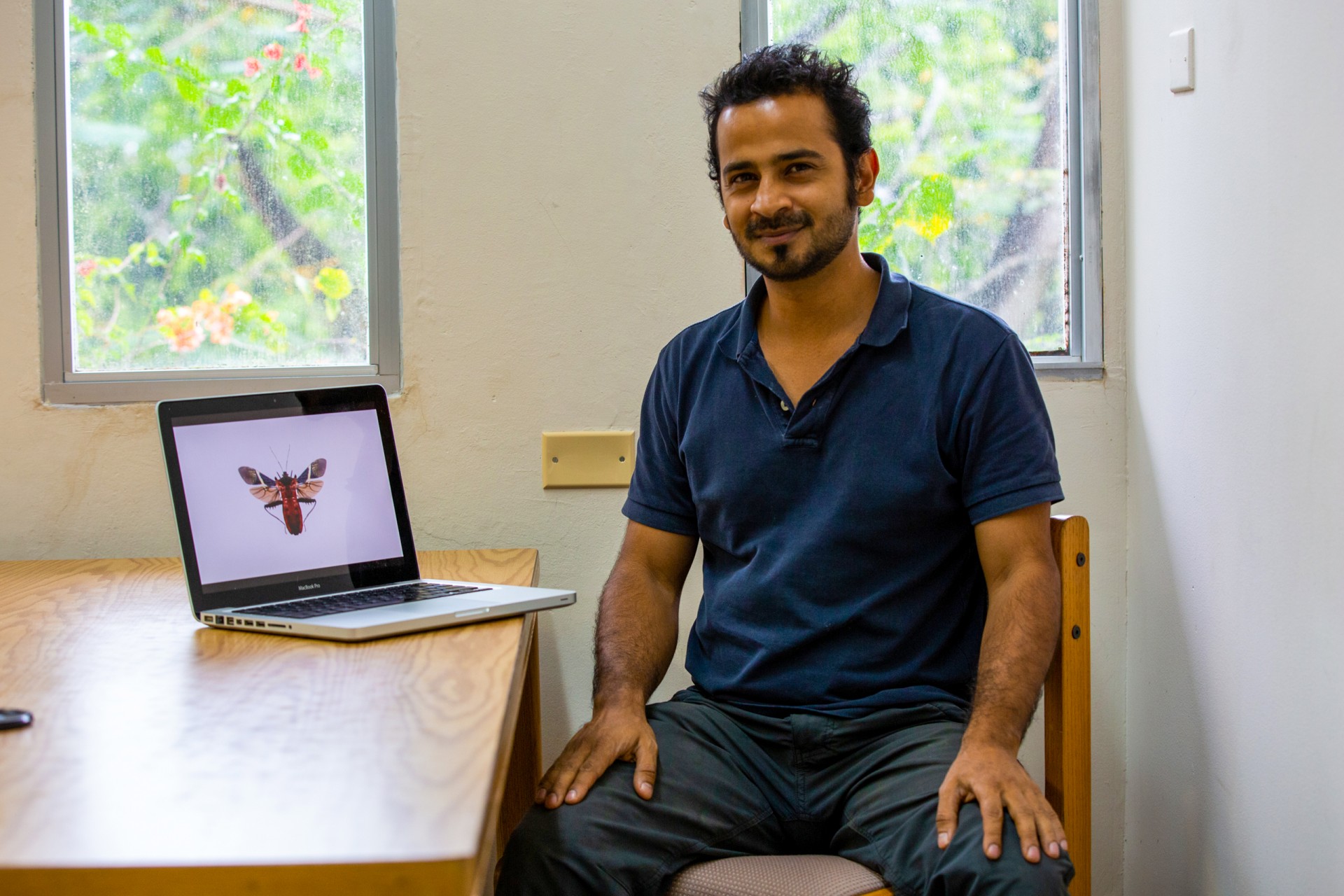Probably
not for sex
The Matador Bug’s
flag-waving mystery deepens
Byline: Beth King
Why do matador bugs wave bright flags on their hind legs? The usual explanation for showoffs in nature is sexual selection, but that’s not it.
Male peacocks shake elaborate trains—a dazzling mating display—and male peacock spiders also dance, showing off brightly-colored abdomens. Nature’s most bizzare, conspicuous displays evolved to attract mates. In Panama, matador bugs wave brightly colored legs, but nobody know why. The go-to explanation is that foot-waving ancestors attracted more or better mates but scientists at the Smithsonian Tropical Research Institute (STRI) say there’s no evidence that the matador bugs wave their legs to attract a sexual partner. Like Darwin, they hope to find a new and better explanation for leg-waving.
“The very nature of discovery is that we can’t anticipate where our questions lead,” said Ummat Somjee, STRI post-doctoral fellow whose work on sexual selection and insect weaponry has been featured in the New York Times, “By following our curiosity we sometimes arrive at unexpected realities, leading us to re-evaluate the very questions we asked in the first place…a powerful exploratory approach to provide insight as we look at nature from a new perspective.”
Fancy features in nature, like the matador bugs’ foot flags, are often explained as a male’s way to attract females. But female matador bugs have foot flags, too…so there is still a mystery to be solved.
Credit: Ana Endara
If males use the flags to signal aggressivity or to attract mates, bigger males would likely have bigger flags and females would probably not have flags. The female peacock does not boast a flashy train. An international team from institutions the United Kingdom, Panama, the United States, Switzerland, and Germany set out to find out if this was the case.
To tell the bugs apart, they marked each with dots of non-toxic paint. Then they put three bugs in a large, screened enclosure and noted the location of each about every two minutes. Video of the entire cage set up during the experiment kept track of the bugs’ behavior after the experimenter left the room. They recorded how long the bugs waved and the distance between the three bugs in each round. Overall, they documented more than 745 wave displays.
All their evidence indicates that flag-waving is not about sexual attraction.
The size of the flags did not change depending on the sex of the bug. For both males and females, bigger bugs usually had bigger flags. Females had larger bodies than males overall, but their flags were not bigger than flags of males of the same size. Males and females both waved about the same number of times and at about the same rate. Insects were more likely to wave when others were further away, not when they were closer to each other. So no differences were found in waving behavior between males and females. It didn’t matter if the groups of bugs were all male, all female or mixed.
If sex isn’t the reason for this behavior and these structures, then why do these bugs wave their legs?
Maybe flag-waving lures predators away from important body parts. Nearly one in six matador bugs in the wild is missing a hind leg. Maybe it is better to sacrifice a leg, than to be directly attacked. Perhaps, like a bullfighter in a ring, the brightly colored legs act as the matadors’ cloak, to distract attacks away from the main body? Their future experiments will test these ideas.
Ummat Somjee, Tupper Post-doctoral Fellow, Smithsonian Tropical Research Institute
Credit: Jorge Aleman, STRI
Why is this important? In Panama, where this work was done, and in neighboring Costa Rica, matador bugs, Anisosclelis alipes, are common pests on passion fruit, Passiflora edulis, farms. Who knows? Maybe knowing more about how matador bugs interact with predators could result in a better way to protect plants than spraying chemical insecticides that also kill beneficial insects: something to test in the future. Good ideas come from paying attention and doing careful research to better understand the natural world.
The first author of the paper, Cameron Longbottom, was an undergraduate intern from Manchester University in the United Kingdom:
“Being in the field in Panama is so different from watching Avatar on the internet. To see animals in their own habitats—you don’t get that in many places—to study this bug that’s on the cover of the Lonely Planet guidebook and the Magic Web, but no one knows anything about it. I would love to go back. There is still so much to learn.”


